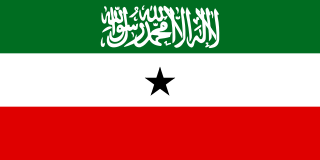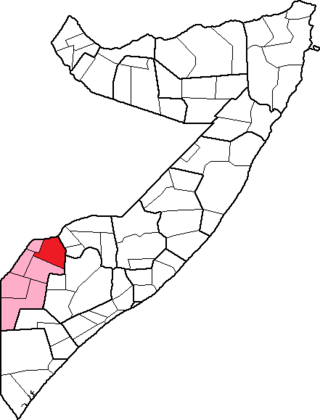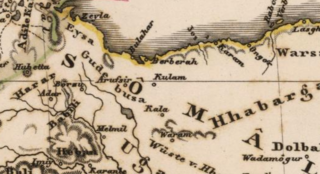Related Research Articles

Somali, officially the Federal Republic of Somalia and formerly known as the Somali Democratic Republic, is a country located in the Horn of Africa. The country was an important centre for commerce with the rest of the ancient world, and according to most scholars, it was the seat of ancient Land of Punt that thrived during bronze age. During the classic era until the Middle Ages, several powerful Somali states and port towns dominated the regional trade, including the Sultanate of Mogadishu and the Ajuran Sultanate, both centered around the port town of Mogadishu. Additionally, the port towns of Barawe and Merca played significant roles in this commercial network which were part of the Azania city states during classic era. Preceding these medieval states were ancient civilisations such as the legendary Macrobian Kingdom, noted by Herodotus for its wealth and wisdom, and the Barbario civilisation, an early pre-Islamic civilisation that helped lay the foundations for the region's prosperous trade routes.

Somaliland, officially the Republic of Somaliland, is an unrecognised country in the Horn of Africa. It is located in the southern coast of the Gulf of Aden and bordered by Djibouti to the northwest, Ethiopia to the south and west, and Somalia to the east. Its claimed territory has an area of 176,120 square kilometres (68,000 sq mi), with approximately 6.2 million people as of 2024. The capital and largest city is Hargeisa.

The Horn of Africa (HoA), also known as the Somali Peninsula, is a large peninsula and geopolitical region in East Africa. Located on the easternmost part of the African mainland, it is the fourth largest peninsula in the world. It is composed of Somalia, Djibouti, Ethiopia, and Eritrea. Although not common, broader definitions include parts or all of Kenya and Sudan. It has been described as a region of geopolitical and strategic importance, since it is situated along the southern boundary of the Red Sea; extending hundreds of kilometres into the Gulf of Aden, Guardafui Channel, and Indian Ocean, it also shares a maritime border with the Arabian Peninsula.

Banu Hashim is an Arab clan within the Quraysh tribe to which the Islamic prophet Muhammad Ibn Abdullah belonged, named after Muhammad's great-grandfather Hashim ibn Abd Manaf.

The Eidagalle is a major Somali clan of the Isaaq clan family. Members of this clan are concentrated in Somaliland and the Somali region. They are the traditional holders of the Isaaq Sultanate since the 18th century. As descendants of Ismail bin Sheikh Isaaq, its members form a part of the Habar Magaadle confederation, and they constitute the largest sub-clan of the Isaaq. They traditionally consist of nomadic pastoralists, merchants and skilled poets.

The Isaaq is a major Somali clan. It is one of the largest Somali clan families in the Horn of Africa, with a large and densely populated traditional territory.
Hāshim ibn ʿAbd Manāf, born ʿAmr al-ʿUlā, was the great-grandfather of the Islamic prophet Muhammad and the progenitor of the ruling Banu Hashim clan of the Quraysh tribe in Mecca. At some point in his life before his father's death, 'Amr chose for himself the name Hāshim, as it was the name God used for Abraham. The narrations from Islamic hagiographists to explain this name change are varied: A narration suggests that `Amr was called Hashim because Hashim translates as pulverizer in Arabic. As a generous man, he initiated the practice of providing crumbled bread in broth that was later adapted for the pilgrims to the Ka'aba in Mecca. Another narration claims the name derives from the Arabic root Hashm, to save the starving, because he arranged for the feeding of the people of Mecca during a seasonal famine, and he thus came to be known as "the man who fed the starved".

The history of Somaliland, a country in the eastern Horn of Africa bordered by the Gulf of Aden, and the East African land mass, begins with human habitation tens of thousands of years ago. It includes the civilizations of Punt, the Ottomans, and colonial influences from Europe and the Middle East.
The Mudaito dynasty is the ruling dynasty of the Sultanate of Aussa in Ethiopia. It was founded by the Asaihemara Modaito clan of the Afars who came from the La'o and Doobi areas.

Luuq District is a district in the southwestern Gedo region of Somalia. Its capital is the city of Luuq.
Qusai ibn Kilab ibn Murrah, also spelled Qusayy, Kusayy, Kusai, or Cossai, born Zayd, Orphaned early on, he would rise to become chief of Mecca, and leader of the Quraysh tribe. He is best known for being an ancestor of the Islamic prophet Muhammad as well as the third and the fourth Rashidun caliphs, Uthman and Ali, and the later Umayyads, Abbasids, along with several of the most prominent Hashemite dynasties in the orient.
Garad is a term used to refer to a king, Sultan or regional administrator. It was used primarily by Muslims in the Horn of Africa that were associated with Islamic states, most notably the Adal Sultanate.
Yusuf bin Ahmad al-Kawneyn, popularly known as Aw Barkhadle or Yusuf Al Kownayn, was an Islamic scholar and traveler based in Zeila, Somaliland. According to Dr. Enrico Cerulli, Yusuf Al Kawneyn is referenced in the Harar manuscripts.
Guled Abdi was a Somali ruler. He was the first Sultan of the Isaaq Sultanate and his numerous offspring would form the Rer Guled and continue to lead after his death.

The Isaaq Sultanate was a Muslim sultanate that ruled parts of the Horn of Africa in the 18th and 19th centuries. The kingdom spanned the territories of the Isaaq clan in modern-day Somaliland and Ethiopia. It was governed by the Rer Guled Eidagale branch of the Garhajis clan and is the pre-colonial predecessor to the Republic of Somaliland.

The Habr Yunis Sultanate was a Somali kingdom that ruled parts of the Horn of Africa during the 18th century. It spanned the territories of the Habr Yunis clan which is part of the wider Isaaq in modern day Somaliland and Ethiopia. The sultanate was governed by the Rer Ainanshe branch of the Habr Yunis clan.

Ishaaq bin Ahmad bin Muhammad, more commonly known as Sheikh Ishaaq or Sheikh Isaaq was an Islamic scholar of the Shafi’i school who crossed the sea from Arabia to the Horn of Africa. He is traditionally regarded as the Sayyid forefather of the Isaaq clan-family in the Horn of Africa, whose territory is wide and densely populated.

House of Guled was the ruling house of the Isaaq Sultanate from 1750 to 1884 and is also a subclan in its own right. The family are descendants of the Eidagale sub division of the wider Garhajis and in extension Isaaq clan-family. Although they no longer hold any authority, they are the royal house of Somaliland and are viewed as a favoured symbol in the country. In July 2021, Sultan Mahamed Abdiqadir had a state funeral with nationwide media coverage and was attended by high government officials, including the president of Somaliland; Muse Bihi Abdi and foreign dignitaries.

The Battle of Lafaruug took place in 1749 when Abdi Eisa, the father of the first Isaaq sultan, Sultan Guled Abdi, led the Isaaq forces to victory over the Absame and Ogaden tribes near the town of Lafa-Ruug. This battle established the dominance of the Isaaq Clan in the region and marked the beginning of the Isaaq Sultanate a year later.

The Isaaq Kingdom was a Muslim Somali-Arabic kingdom that emerged after the fall of the Adal Sultanate between the 14th until it was overthrown by a coalition of Isaaq in the middle of the 18th century. according to oral tradition, the kingdom was led by the Tol Jeclo branch of the Greater Isaaq clan Family, where they ruled for centuries starting from the 13th century. It was the predecessor to the more widely known Isaaq Sultanate which ruled from 1749 to 1884 under the Guled Dynasty.
References
- ↑ Minahan, James B. (2016-08-01). Encyclopedia of Stateless Nations: Ethnic and National Groups around the World. Bloomsbury Publishing USA. pp. 184–185. ISBN 979-8-216-14892-0.
- ↑ "Degmada Cusub Ee Dacarta Oo Loogu Wanqalay Munaasibad Kulmisay Madaxda Iyo Haldoorka Somaliland". Hubaal Media. 2017-10-07. Archived from the original on 2021-08-11. Retrieved 2021-08-11.
- ↑ "Taariikhda Toljecle". www.tashiwanaag.com. Retrieved 2021-08-09.